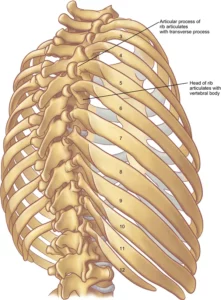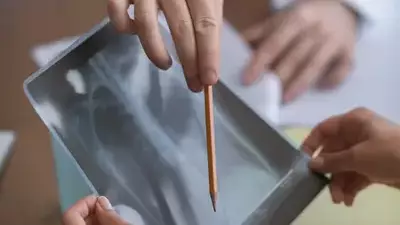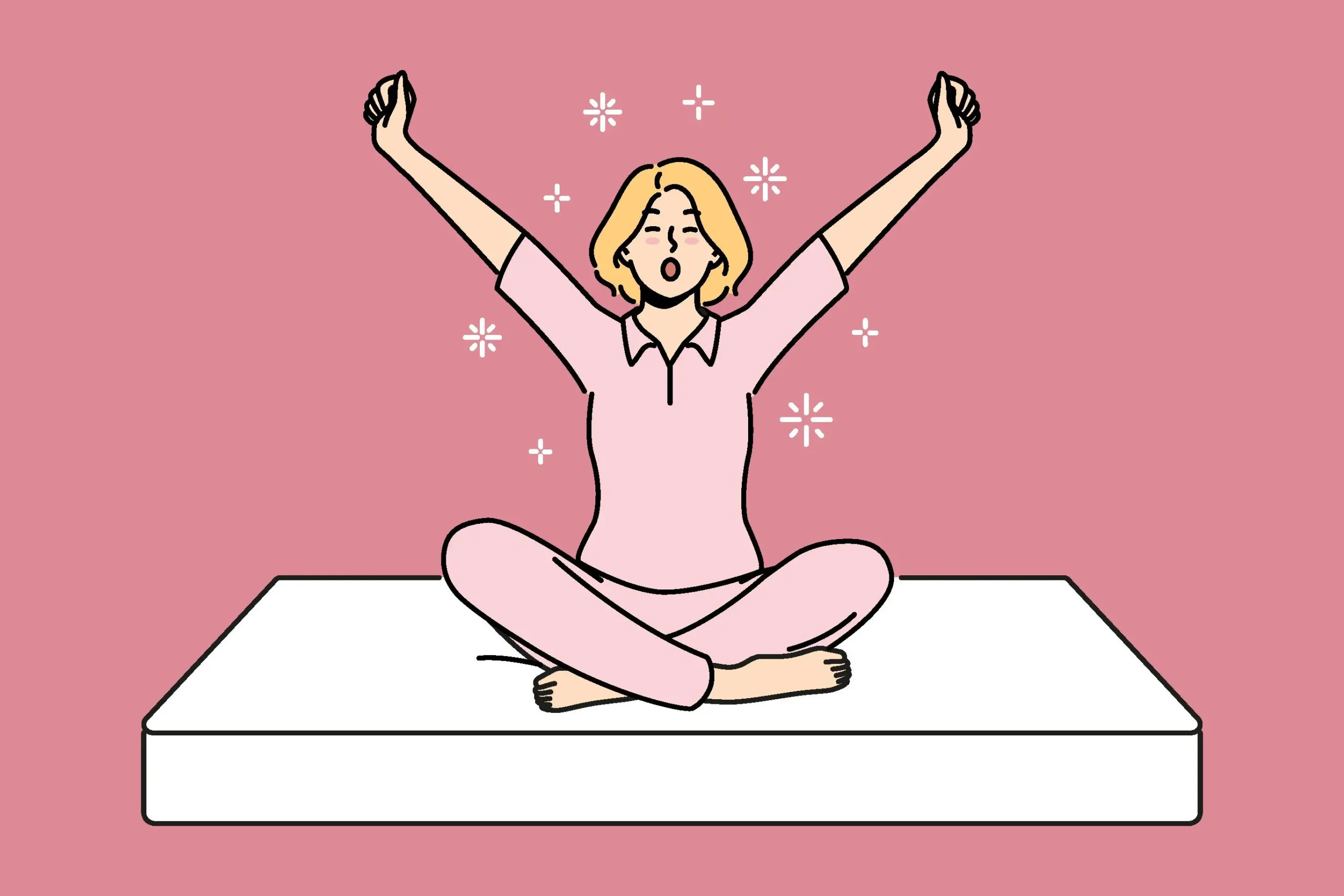“What causes middle back pain chest pain?” is a common question from patients in our office. Pain in the middle back is a common issue affecting many people at some point. It can range from mild discomfort to severe pain that impacts daily activities. This article is not just a source of information but a guide that aims to comprehensively understand the causes, symptoms, and various treatment options for middle back pain.
Table of Contents
ToggleAnatomy of the Middle Back

The Spine
The spine, or vertebral column, consists of 33 vertebrae, with 12 thoracic vertebrae (T1-T12), where the ribs attach.
The Rib Cage
The rib cage is made up of 12 pairs of ribs:
- True Ribs (1-7): These are connected directly to the sternum (breastbone) at the front.
- False Ribs (8-10): These connect to the sternum indirectly through cartilage.
- Floating Ribs (11-12): These don’t connect to the sternum at all and end in the muscles of the lower back.
Rib and Spine Interaction
Each rib connects to the spine at two points:
- Costovertebral Joint: The rib attaches to the body of a thoracic vertebra.
- Costotransverse Joint: The rib connects to the transverse process of a thoracic vertebra.
These joints allow the ribs to move slightly during breathing and other activities.
Spine and Rib Joint Motion During Activity
When you move your upper body—such as twisting or bending—the ribs and spine work together to provide stability and flexibility. Here’s how:
- Twisting: The ribs rotate around the spine, allowing you to turn your torso.
- Bending Side to Side: The ribs on one side come closer together while those on the other side spread apart.
- Bending Forward and Backward: The rib cage expands and contracts slightly to accommodate these movements.
Breathing: Inspiration and Expiration
Breathing involves the coordinated movement of the ribs and diaphragm (a large muscle below the lungs).
- Inspiration (Inhaling):
- The diaphragm contracts and moves downward, increasing the space in the chest cavity.
- The ribs move upward and outward, like the handle of a bucket being lifted. This movement is called the “bucket-handle” motion.
- The front ends of the ribs also lift, similar to how a pump handle moves.
- These movements increase the volume of the chest cavity, allowing the lungs to expand and fill with air.
- Expiration (Exhaling):
- The diaphragm relaxes and moves upward, decreasing the space in the chest cavity.
- The ribs move downward and inward, reducing the volume of the chest cavity.
- This pushes air out of the lungs.
Simple Visualization of Rib Motion
Imagine the rib cage as a birdcage and the spine as the pole that holds it up. When you twist or bend the birdcage, it moves around the pole. When you breathe in, the birdcage expands; when you breathe out, it contracts.
Common Causes of Middle Back Pain, Chest Pain
Middle back pain can result from various factors, including:
- Poor Posture: Long periods spent at a desk or hunched over a phone or tablet create a forward head posture and strain the thoracic spine.
- Muscle Strain: Overuse or sudden movements can cause muscle strains or sprains in the back.
- Injury or Trauma: Slips, falls, car accidents, and sports injuries can damage the spine or surrounding muscles.
- Herniated Discs: Discs that bulge or rupture can press on nerves, causing pain.
- Arthritis: Chronic inflammation of joints, whether from overuse or old injuries, can lead to degeneration and chronic pain.
- Osteoporosis: A loss of bone density, resulting in a weakening of the bones, can result in fractures, particularly in the spine.
- Scoliosis: Overuse, poor posture, and congenital malformations of the bones in the spine can result in an abnormal curvature of the spine. These unnatural changes cause uneven stress, joint wear, and pain.
How Are Middle Back Pain and Chest Pain Connected?
There are several different possible causes of back pain radiating to the chest. Below are the three causes that, while painful, respond very well to affordable Chiropractic adjustments.
Subluxated Vertebrae
A misaligned vertebra is very often what causes middle back chest pain. Slips, falls, heavy lifting, and repetitive motion can all cause injury to the thoracic spine. When a traumatic injury occurs in the spine, it is usually noticed immediately. However, poor work ergonomics and the slow changes associated with arthritis can cause the symptoms to present more slowly. When a bone in the back is misaligned, it will cause joint pain, muscle spasms, and nerve irritation.
Muscle Spasm
When a joint in the body is inflamed (swollen), the muscles near it tighten to act like a “splint” to prevent it from moving. If the inflammation is from an injury, this is how the body protects it so it can heal.
The intercostal muscles connect the ribs and are responsible for the motion that allows us to breathe in and out. When the joint that connects the rib to the spine (costovertebral joint) is injured, the intercostal and back muscles tighten as a protective mechanism. This can cause difficulty breathing and shortness of breath.
Chiropractic adjustments can restore motion to stuck joints, typically providing rapid relief. Electric muscle stimulation, low-level laser therapy, and Acupuncture can also provide the fastest relief possible.
Nerve Pressure (Intercostal Neuritis)
A subluxated vertebra can pressure the thoracic spinal nerve as it passes between the bones in the spine. Just 10mmHg of pressure on one of these nerves can result in pain that radiates along the rib. Intercostal muscle spasms can also compress these susceptible nerves, resulting in pain along the ribs and chest.
When is Middle Back Pain and Chest Pain an Emergency?
Heart conditions
Pain in your heart can radiate through your chest and back. The most common type of pain related to heart disease is called angina. It happens when your heart muscle isn’t getting enough blood flow (myocardial ischemia). Angina is a chronic pain that comes and goes and may worsen over time.
Angina
What does angina feel like?:
- Tightness or squeezing in your chest.
- Heavy, crushing pressure in your chest.
- Uncomfortable fullness with a burning quality, like indigestion.
- Pain that moves or spreads from your chest to other parts of your upper body.
Angina pain may spread from your chest to your:
- Back
- Stomach
- Neck
- Jaw
- Shoulders
- Arms
Other symptoms besides pain might include:
- Shortness of breath
- Sweating
- Nausea
- Dizziness
- Fatigue
- Anxiety
Angina can be a precursor to a heart attack. A heart attack is a severe episode of angina. It happens when blood flow to your heart stops long enough to damage your heart muscle. The symptoms of both conditions are the same. If you experience these symptoms, seek immediate medical care.
Pericarditis
Infection or inflammation of the protective sac around your heart (your pericardium) can cause a different type of chest pain. This condition is called pericarditis. It usually develops suddenly and lasts a few weeks to months. Occasionally, it lasts longer or returns after going away the first time.
Pericarditis might feel:
- Dull and sore sometimes, sharp and stabbing at other times
- Worse when you cough, swallow, breathe deeply, or lie down
- Better when you sit up and lean forward
- Like your heart is beating harder or irregularly
The pain might spread from your chest to your:
- Back
- Neck
- Shoulders
- Stomach
Other symptoms might include
- Fever and chills
- Trouble breathing when lying down
- Joint pain
- Swelling in your legs and feet
Pericarditis is usually a temporary condition related to a passing viral infection. But occasionally, when it’s more severe, it can lead to serious complications. It’s always best to see a healthcare provider about pain that feels like it involves your heart or pain that matches the description of angina or pericarditis.
Lung conditions
Your lungs are in the back of your chest cavity, just in front of your spine. Pain in and around your lungs can involve your chest and back. The most common causes are infections, like pneumonia and bronchitis. Infections cause inflammation of the lining of the lungs and, sometimes, fluid build-up.
Chest infections
Pain related to chest infections can feel:
- Sharp and stabbing
- Tight and constricting
- Worse when you breathe or cough
- Worse when you lie in bed longer
It can spread from your chest to your:
- Back
- Shoulders
Other symptoms might include:
- Dry cough
- Wet cough
- Coughing up blood
- Shortness of breath
- Fever
- Fatigue
A cough is a strong clue that you have an infection. If it’s severe enough to cause chest and back pain, it’s worth a call to your healthcare provider. You might need antibiotics to prevent it from worsening. If you don’t have a cough, you could have lung inflammation for another, more profound reason.
Pulmonary Embolism
A pulmonary embolism (PE) is a blood clot in the lungs. It is another relatively common and severe cause of chest and back pain. A PE restricts blood flow to the lungs and increases blood pressure in the pulmonary arteries. It also suddenly or gradually reduces the oxygen in the lungs.
Pulmonary embolism feels like:
- Sudden or gradually increasing shortness of breath.
- Sharp, stabbing chest pain, primarily when you breathe in.
- Unexplained back, shoulder, arm, neck, or jaw pain.
- Pain that worsens with exercise or stress.
A pulmonary embolism can be fatal. If you have symptoms of a pulmonary embolism, seek immediate medical attention.
Biliary pain
Your biliary system is the network of organs that pass bile and other digestive juices through your bile ducts. Most of these organs are in your upper abdomen, mainly on the right side. Biliary pain will often radiate to your right ribcage, shoulder blade, and back. Gallstones are the most common cause.
A gallstone that blocks one of your bile ducts or your pancreatic duct will cause inflammation and pain in your biliary system. The most common symptom is biliary colic, a pattern of pain that occurs in episodes, often after eating. It builds to a peak and then subsides. It’s intense and usually accompanied by nausea.
Other causes of Biliary pain are inflammation of the pancreas (Pancreatitis), bile duct (Cholangitis), gall bladder (Cholecystitis), and liver (Hepatitis).
Biliary Pain is Serious
If you experience an episode of biliary colic, even though it might go away, you still need treatment. Biliary colic will return until the blockage in your biliary system is removed, and it’s also likely to get worse. If you develop a complete blockage, it will become an emergency.
What Causes Your Back to Hurt in the Middle
Middle back pain can present in many different ways. Typical presentations of middle back pain are:
- Dull, aching pain in the thoracic region
- A sharp, stabbing pain that sometimes radiates along the rib or sternum
- Muscle stiffness or tightness
- Limited range of motion
- Pain that worsens with specific activities or positions
Fortunately, what causes your back to hurt in the middle, most commonly, is a spinal misalignment (subluxation). Why is this fortunate? Because these types of injuries respond amazingly to common treatments like Acupuncture, Chiropractic Adjustments, and Dry Needling.
Diagnosing Middle Back Pain, Chest Pain
Proper diagnosis of middle back pain is crucial for effective treatment. At Integrative Health and Rehab, a doctor specializing in spinal function will perform a thorough evaluation, including:
- Medical History: Discussing symptoms, medical history, and lifestyle factors
- Physical Examination: Assessing posture, range of motion, areas of tenderness, and performing orthopedic tests
- Imaging Tests: Digital X-rays to visualize the spine and identify abnormalities
Chiropractic Care for Middle Back Pain, Chest Pain
A Chiropractic adjustment is the most effective, non-invasive, drug-free treatment for middle back pain. An integrative Denver chiropractor is thoroughly trained to recognize, diagnose, and treat spine disorders. Our Denver Chiropractors use only the most effective therapies to treat middle back pain and chest pain.
Spinal Adjustments
Spinal manipulation, or more simply, Chiropractic adjustment, is the hallmark of chiropractic care. This manual technique involves applying controlled force to the spine to improve alignment and mobility. Benefits of spinal adjustments include:
- Reducing pain and inflammation
- Enhancing range of motion
- Improving spinal function
- Promoting overall well-being
Exercise and Rehabilitation
We will provide you with specific exercises and stretches to strengthen the muscles supporting the spine, improve posture, and relieve your pain. A tailored exercise program can:
- Prevent future injuries
- Enhance core stability
- Improve long-term spinal health
Lifestyle and Ergonomic Advice
Aside from the Chiropractic adjustment, Chiropractors will also provide lifestyle modifications and ergonomic advice to help prevent your middle back pain. This may include:
- Advice on proper posture
- Recommendations for ergonomic workstations
- Tips for safe lifting techniques
- Guidance on maintaining a healthy weight
Additional Treatment Options for Middle Back Pain
While chiropractic care is highly effective, it may be complemented by other treatments for optimal results. Some additional treatment options include:
- Acupuncture: This time-tested treatment effectively relieves pain, muscle spasms, and inflammation.
- Cold Laser Therapy: Advanced technology to reduce pain and inflammation.
- Dry Needling: Targeted therapy to relieve muscle tension and promote healing.
- Electroacupuncture: A combination of traditional Chinese Acupuncture with modern electric muscle stimulation.
- Shockwave Therapy: Non-invasive treatment to accelerate tissue repair and reduce pain.
Preventing Middle Back Pain
Prevention is the key to managing middle back pain and maintaining a healthy spine. Here are some tips to help prevent middle back pain:
- Maintain Good Posture: Keep your spine aligned and avoid slouching. Use ergonomic chairs and desks.
- Stay Active: Regular exercise strengthens the muscles supporting the spine. Incorporate activities like walking, swimming, and yoga.
- Lift Safely: Use proper lifting techniques, bend at your knees, and avoid lifting heavy objects alone.
- Maintain a Healthy Weight: Excess weight can strain your spine, so aim for a healthy weight through diet and exercise.
- Stay Hydrated: Drinking plenty of water keeps your discs hydrated and helps maintain spinal health.
- Take Breaks: If you sit long, take regular breaks to stand, stretch, and move around.
Integrative Health and Rehabilitation: Your Partner in Spinal Health
At Integrative Health and Rehabilitation, we understand the challenges of living with middle back and chest pain. Our team has extensive knowledge and is dedicated to providing the best care available. You can trust our expertise and commitment to your well-being.
Why Choose Integrative Health and Rehabilitation in Denver, CO?
- Experienced Team: Our skilled chiropractors and therapists have years of experience treating middle back pain.
- Comprehensive Approach: We offer a holistic, multi-modal approach to treating pain. By combining chiropractic with other proven treatments, we achieve optimal results.
- Personalized Care: We use effective, proven treatments tailored to your needs and goals.
- State-of-the-Art Facility: Our clinic has advanced technology to provide the highest quality care.
- Patient-Centered: Your health and well-being are our top priorities. We are committed to helping you achieve a pain-free, active lifestyle.
Middle Back Pain, Chest Pain is Serious But Can Be Treated
Middle back pain can significantly impact your quality of life, but treatment is available. The Chiropractic adjustment offers a safe, non-invasive solution to alleviate pain and improve spinal health. Integrative Health and Rehabilitation is committed to helping you achieve lasting relief and a pain-free lifestyle. If you’re in Arvada, Denver, or Wheat Ridge, CO, and suffering from middle back pain radiating to the ribs or chest, contact Integrative Health and Rehabilitation today to schedule an appointment.
Doctor Doran has over 25 years of experience treating back pain, neck pain, and headaches. Schedule a free consultation at our affordable chiropractic clinic and learn why he is the Chiropractor Denver seeks for fast, effective, and lasting pain relief. Don’t resort to potentially dangerous medications like Diclofenac (Voltaren), or just wait and hope to start feeling better. Let us help you get back to living your best life.

Ready for an expert opinion? Get in touch today!
With a legacy of more than 25 years, our team specializes in helping individuals triumph over back pain, neck discomfort, and persistent headaches, all without relying on addictive medications or risky surgical procedures.






